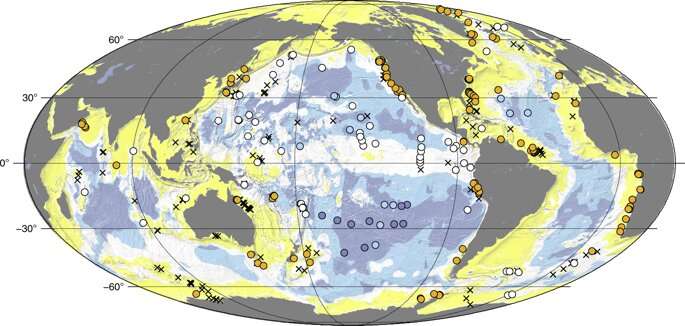Global distributions of dissolved O2 and SO42− in subseafloor sediment. In yellow regions, dissolved SO42− is expected to disappear within the sediment and HCO3− is expected to be the predominant net electron acceptor at greater depths. In white regions, dissolved SO42− is expected to penetrate throughout the sediment, from seafloor to igneous basement. Dark blue and light blue regions respectively represent the minimum and maximum areas over which dissolved O2 is expected to penetrate throughout the sediment from seafloor to basement16. SO42− reduction is expected to dominate net subseafloor organic oxidation in the yellow and white regions. O2 reduction is expected to dominate net subseafloor organic oxidation in the blue regions. Orange dots mark drill sites where SO42− disappears within the first 500 meters of sediment. White dots mark drill sites where SO42− penetrates the entire sediment sequence. Dark blue dots mark drill sites where dissolved O2 and dissolved SO42− penetrate the entire sediment sequence. Medium blue dots mark coring sites where O2 and SO42− penetrate to the bottom of the cores (meters to tens of meters) and may penetrate to basement. X symbols mark sites where the full extent of SO42− penetration is unknown, because SO42− is present in all measured samples, but the sedimentary sequence continues far below the last measurement.
University of Rhode Island oceanographer Steven D"Hondt and his collaborators have studied the microbial life that lives deep beneath the seafloor—including the rate at which it breathes and how much food it consumes—for more than 20 years, and they have made some significant discoveries.
Now D"Hondt and fellow URI oceanographers Robert Pockalny, Victoria Fulfer and Arthur Spivack have synthesized the results of dozens of related studies to determine how subseafloor life affects the world above the water line. And their findings are somewhat surprising.
Their analysis was conducted at the request of the editors of the journal Nature Communications, as part of a series of articles about the Earth's biogeochemical cycles.
"Respiration of subseafloor life has long-term impacts on the chemistry and the climate at the surface," D"Hondt said in summarizing his findings.
According to D"Hondt, the world is enriched with oxygen because organic matter sinks to the seafloor and becomes buried, and because subsurface life—microbial cells of many varieties—eats the buried organic matter, leaving behind oxidized chemicals. This process is a vital link in the carbon cycle, in which carbon compounds travel from the atmosphere to the Earth and oceans and back into the atmosphere.
"If subsurface life was completely efficient, the surface world would be much less oxidized," he said. "But it's not completely efficient. What they leave behind—the leftovers of their meals—is what determines how much oxygen is in the world around us.
"So the only way to build up oxygen in the air over billions of years is to continually bury organic matter," D"Hondt added. "When subsurface organisms eat the organic matter, they're basically reversing photosynthesis and removing oxidizing power from the world above."
The URI scientist believes that studying the complex details of the carbon cycle and the role of subseafloor life on global climate is useful in developing a better understanding of the evolution of Earth.
"There's a perception, even among some scientists, that the surface world and the subsurface world are decoupled, but they're not," he said. "The surface world feeds the subsurface world, and the subsurface world affects the chemistry of the surface world. They're in communication with each other. Subsurface organisms change the chemistry of the ocean, and they change the chemistry of the atmosphere."
Many questions about the details of this process and their implications remain unanswered, according to D"Hondt, including the factors that limit subsurface respiration, at what rate the process occurs, and how these processes change over time. But he is confident that the answers will be forthcoming.
"These microbes breathe orders of magnitude more slowly than is necessary for them to divide, and yet they live in sediment 100 million years old," he said. "Have they lived for 100 million years, or are they dividing and accumulating energy over millennia and dividing really slowly? Or do their sources of energy include something we haven't thought of? There's something in our set of assumptions that's fundamentally wrong."
More information: Steven D'Hondt et al. Subseafloor life and its biogeochemical impacts, Nature Communications (2019). DOI: 10.1038/s41467-019-11450-z. www.nature.com/articles/s41467-019-11450-z
Journal information: Nature Communications
Provided by University of Rhode Island






















